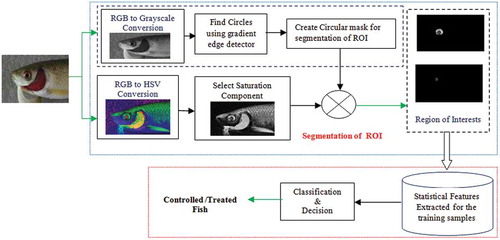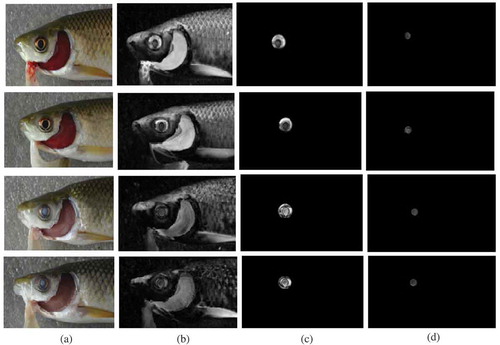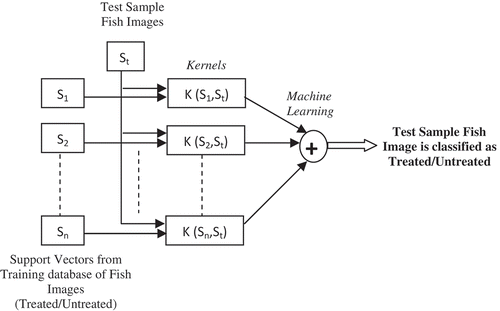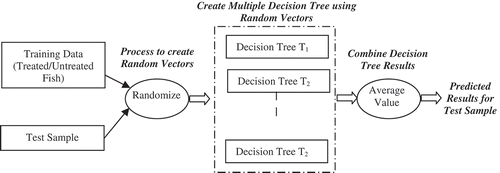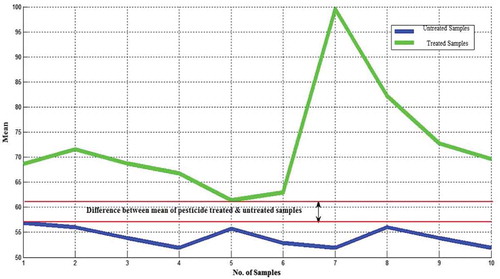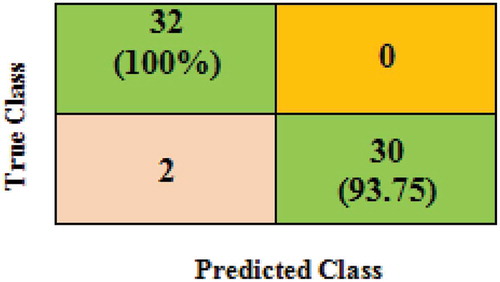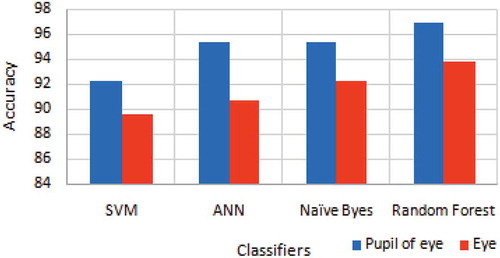ABSTRACT
Different factors like treating, handling, storage, exposure to contaminants and climatic change are responsible for the quality of fish. There is a difference in quality between fishes nurtured in fresh water and in polluted or pesticide affected water. Among different impurities, pesticide is one of the major threats to fish quality and human health. Identification and detection of pesticide contamination in fish is a challenging task and conventional methods need number of costly devices and expert manpower. This paper intends to provide a non-destructive computer-aided method for identification of quality differences between pesticide exposed fish and fresh water fish. In the proposed image processing method, the fish eye tissue was selected as the main region for extraction of different features in spatial domain. Statistical features were selected in spatial domain and then these features were analysed for discriminatory variation using strategic image processing techniques. These analysed features were correlated to pesticide treated and fresh water fish using machine learning methods. Different classifiers were used for automatic classification on the extracted features. The experimental results illustrate the efficiency of proposed method and the accuracy of identification is 96.87%. The computational time is less, making it practically well-suited for fish quality assessment in real time.
Introduction
Aquaculture’s meteoric rise during the last two decades provokes both optimism and apprehension among scientists and policy analysts who are concerned with global food security. Aquaculture currently provides approximately half of the fish consumed worldwide and is expected to increase in the future, as wild fisheries exceed their sustainable limits while aquaculture technology and management continues to improve.[Citation1] Pollution in the aquatic environment caused by inorganic and organic chemicals is a major factor posing serious threats to the survival of aquatic organisms[Citation2] including fish. Due to improper storage and handling, containers often get damaged, sacks become rotten and metal drums are corroded, resulting in leakage of pesticides to the surrounding environment.[Citation3] Among different aquatic pollutants, pesticides creep into different aquatic bodies as a natural outflow from agriculture fields.[Citation4] Wastes from pesticide manufacturing industries are one of the important challenges[Citation5] for fish quality. There are different parameters which may influence the quality of fish products (e.g., safety, eating characteristics, physical attributes, nutritional value, availability, freshness, convenience and integrity).[Citation6] There are some conventional instrumental and sensory methods (e.g., chemical, physical, biochemical and microbiological) developed for the evaluation of fish quality. The freshness which can be associated with the time since fish species have been found can be estimated over sensory aspects, odour, colour and texture.[Citation7,Citation8] When seafood is consumed, their freshness or quality can be perceived by the subconscious or conscious integration of different sensory or organoleptic characteristics, which may be grouped as odour, appearance, texture and flavour. In most cases, the first opportunity to evaluate the quality or freshness of seafood is conducted by its appearance.[Citation9,Citation10] The components included in e-tongue consist of automatic sampler, array of chemical sensors and data processing systems. Applications include process monitoring, freshness evaluation, shelf-life investigation, authenticity assessment, foodstuff recognition, quantitative analysis and other quality control studies.[Citation11]
In different types of pesticides, cypermethrin is one of synthetic pyrethroid and is extensively used to eliminate multiple crop pests. It is also applied in fish ponds to control Argulus sp. Identification of pesticide’s effect on fish quality or freshness is the most required aspect and detection of pesticide residue in fish is an important step towards this. Conventional process is costly and tedious, as sophisticated and costly instruments like Liquid chromatography–mass spectrometry (LC–MS) and Gas chromatography–mass spectrometry (GC–MS) are required, which are often non-accessible to common community. Some work has been done on the effects of pesticides exposure, physiological changes and biochemical changes in fish, but very little attention has been paid to find the real effects.[Citation12]
Imaging methods in food quality assessment
The conventional chemical, biochemical, microbiological and sensory methods are expensive, tedious, destructive, time consuming and labour-intensive approaches which need expert manpower. Although, these methods are widespread methods for fish freshness assessment, some non-invasive measurements have been developed for continuous determination of fish freshness during storage.[Citation13,Citation14] A recent method have used colour change profile for each sample and analysed the digital data using principal component analysis.[Citation15] The colour can be considered as an important parameter which can be used for human perception, determining quality and safety of the samples. Thus, it can be used as an important attribute for grading food samples.[Citation16,Citation17] Food items are susceptible to colour changes with decrease in freshness.[Citation18,Citation19] The analysis of any food sample using imaging techniques is non-destructive and non-hazardous. Geometrical features and machine learning has been used for surface and volume modelling of fruit.[Citation20] Machine vision technique has been recently introduced to acquire and analyse the image of a real scene. By analysing the colour variations, the exact freshness of the fish can be determined.[Citation21,Citation22] Some researchers have proposed non-destructive methods for fish quality assessment using gills tissue.[Citation23,Citation24] The food industry has made numerous efforts to measure and control the image parameters of their products because of increased demand requirements for quality by consumers. Qualitative visual evaluation is carried out for different operations in existing food image inspection methods by trained manpower in well-illuminated rooms.[Citation25] Objective of this work is to detect the quality of fresh water fish and pesticide exposed fish using automatic image processing methods and machine learning.
Design challenges in classification between untreated (fresh water) and pesticide
Treated fish
There are numerous design challenges that are associated with extraction of distinctive features from sample images of fish to automatically discriminate between pesticide-treated and fresh water fish samples. Some of the key challenges are listed below:
Automatic selection and segmentation of region of interest is an important part of any image processing-based technique. A homogenous region reduces the interference of background and noise and it also makes the method less complex and computationally fast.
Selection of the proper domain for feature extraction plays an important role in differentiating fresh from contaminated quality.
Classification of features with machine learning should be robust and reliable. Hence, selection of prominent features is an important step for discrimination between two groups. The challenge is to select discriminatory features which will aid accurate classification of data.
The main contribution of the proposed work is an automatic assessment scheme of fish quality after pesticide exposure using image processing techniques. This has been achieved by analysing the segmented region of interest of the fish image in saturation channel of the colour space transform. The image pixel statistical distribution of the eye region from the sample images has been analysed and strategically used for classification between pesticide treated and fresh water fish. Features of the eyes are found to have discriminatory variation in image which gives an efficient and accurate framework for classification. The proposed method achieves 96.87% accuracy when random forest method is applied for automatic machine learning-based classification.
The main motive of the proposed work was to design a framework for classification between pesticide exposed and fresh water fish using automatic image processing methods. The chemical-based analysis of fish freshness is a destructive technique because some external factors are added to the sample which can make it redundant for any further usage. The image processing-based method is a non-destructive and non-hazardous technique that can be beneficial as it will only capture the image of the samples without causing any physical, biological or chemical changes in the samples. Also the reusability of the sample still exists. The captured images can be subjected to various processing techniques which involve segmentation and classification. A detailed analysis of the discriminatory features is useful in development of a viable tool in this regard.
Material and methods
Data collection
The proposed method is applied on the Indian Rohu (L. rohita) fish samples. These samples were collected from the fish ponds of National Institute of Abiotic Stress Management, Baramati, Pune, Maharashtra, India. The geographical co-ordinates of the location from where the samples were collected are 18°09”30.62ʹN and 74°30”03.08ʹE and height of 570 m from the mean sea level. The fish samples under test were taken from the pond and kept in an aquarium for 24 hours before experimentation. The fish samples were found to have an average length and weight of 21.60 ± 0.50 cm and 90.40 ± 1.20 g respectively. The experimentation was done using 1 ppb dose of cypermethrin on fishes in three sets for seven days and after that fishes with and without the dose of cypermethrin were killed in chilled water to avoid rigor mortise. After this, fishes were preserved in thermocol boxes with a fish to ice ratio of 1:2. The image acquisition was done using a NIKON D90 camera with resolution of 4928 × 3264 having auto illumination and sensor specification −23.6x15.6mm, CMOS sensor. This digital camera was used to capture the images on the first day and then after an interval period of two days, till sixth day. A camera was located vertically at a distance of 56 cm from the fish sample. In the end, gill, eye, skin and tail were dissected out for analysis of residues and preserved at a temperature of −20OC.
Sample extraction for cypermethrin residue analysis
A developed and validated method was used[Citation26] for sample extraction. According to current available samples, amount and weight of salts and solvent volumes were changed from original method of 5 g sample. Variable amounts of sample used for different body parts of the fish like skin, gills and tail are 1.5 g, 2 g and 1 g, respectively. In short, the sample preparation consists of: extraction with 10 mL of acidified acetonitrile (1% acetic acid) in presence of 2 mL of hexane, 1.5 g of sodium acetate and 6 g of magnesium sulphate (MgSO4); keeping a 2 mL portion of the acetonitrile (middle layer) extract (to freeze out the fat contents from the extract) at −20°C for 20 minutes and then cleaning with 150 mg of MgSO4 and 100 mg of CaCl2. Then again supernatant was cleaned by dispersive solid phase extraction with a combination of 50 mg florisil+ 50 mg PSA (primary secondary amine) + 150 mg C18. The supernatant was then filtered by a PTFE membrane filter and finally analysed by GC-MS/MS.
Proposed method
The proposed method mainly consists of two parts: segmentation of region of interest that is pupil of the eye from the fish image and analysis of the extracted features from the segmented region of interest (ROI). Segmentation of eye and pupil is done using the greyscale image and analysis is done via extracting its first-order statistical features like mean, standard deviation and variance of the ‘S’ channel of HSV colour space. For efficient use of features from the image, the eye and pupil of the eye should be accurately segmented from the fish image.
shows the block diagram of proposed method for classification between pesticide exposed and fresh water fishes. To analyse various discriminatory features, a particular ROI is selected from the fish image. RGB image is converted into HSV image and then Saturation component of ROI is selected. The saturation component contains more image information of the eye and the pupil. The first-order statistical features are used to design framework for freshness identification and classification as untreated fish or treated fish. The different processes involved in this method are described in the following subsections.
Choice of ROI (Region of Interest)
On the basis of appearance of the fish, the traditional parameters which can be considered for the identification of the quality of fish are scales, eyes, gill-cover, gills and skin. The eyes in the fish image may produce some visible changes in its image properties which can be used to analyse the freshness of a sample. It can be seen from the images that the eyes of the fresh fish have clear, convex and bright pupil, as compared to the tern, opaque or completely sunken pupils of treated fish. The fish eye is one such region from the fish image which indicates changes and its colour variation. So, the fish eye and pupil of the eye region is segmented and its statistical features are analysed from the saturation channel which seems to be a good option for image processing-based classification.
Region of interest (ROI) segmentation
In this proposed method, the area of the eyes and pupil of the eye is considered as ROI because it contains the most prominent information for classification of untreated and pesticide exposed samples of fish. An input image for ROI segmentation is the colour image of fish samples.
To segment out the eye and pupil of the eye as ROIs, the true colour RGB image is converted into HSV colour space model. In HSV model, the three co-ordinates depict the colours (hue or tint) in terms of their shade (saturation or amount of grey) and their brightness value. As eye of fish has a circular shape so, the circular shapes in original fish image are identified for segmenting the fish eye. Algorithm 1 explains the steps of the proposed method of ROI segmentation from the sample image.
Algorithm 1: ROI (eye) Segmentation
Step 1: Load the RGB colour image IRGB of the fish.
Step2: To create binary mask, RGB image IRGB is converted into greyscale Igrey
Igrey = 0.2989*R + 0.5870*G + 0.1140*B
For binary mask, Imask = (Igrey>0.5)
Step 3: Object edge is detected by using gradient edge detector
Step 4: Detection of circular shape with radius 12 pixels and 20 using equation:
(x – x0)2 + (y − y0)2 − R2 = 0
where, (x0, y0) is the centre of the circle and (x, y) are possible coordinates
Step3: ROI’s are segment out from Irgb by using binary mask Bmask
ROI = IRGB-transpose (Bmask)
Step4: HSV value calculated from ROI in RGB channel.
R’ = R/255
G’ = G/255
B’ = B/255
Cmax = max(R’, G’, B’)
Cmin = min(R’, G’, B’)
Δ = Cmax - Cmin
The conversion is given as:
V = cmax
Step5: Saturation Component is selected from HSV image and by using binary masks
ROI’s are extracted from Saturation Channel.
Binary mask of ROI is created in greyscale image by using above Algorithm. Then with the help of this mask, fish eye (i.e. ROI) is segmented out from original RGB image in HSV channel. depicts the ROI segmentation performed on fish image.
Figure 2. ROI segmentation in fish (a) Original RGB image (b) Grey scale image (c) Binary mask of ROI (d) Extracted S channel using binary mask.
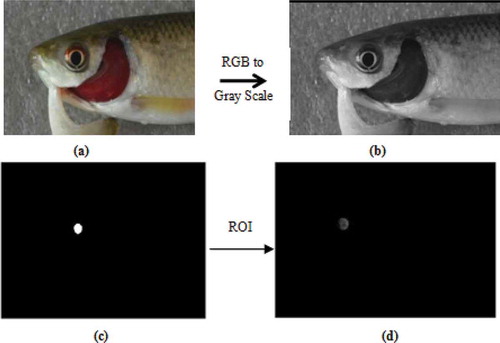
) and ) shows the ROIs segmented from the fish samples images from saturation channel.
Feature extraction from segmented region
The colour of the eye and pupil of the eye being black and grey colour has maximum content present in the saturation channel. The ROI is segmented using saturation channel to extract the different features in spatial domain. First-order statistical features’ mean, standard deviation and variance are calculated for both ROI eye and pupil of the eye. The appearance of the eye of dead fish varies day wise[Citation27] as shown in . Grade 3 represents the appearance of fresh fish and Grade 0 represents the appearance of stored fish. Eye of fresh fish appears black and its colour changes gradually with time and becomes greyish. Similarly,[Citation28] presents a study that shows the sensitivity of eye tissue to pesticide. First-order statistical feature of images is the measure of statistical distribution of pixel intensities which may have discriminatory behaviour to separate fresh water fish and pesticide exposed fish using eye as ROI.
Table 1. Appearance of Eye.
If the original characteristics of a product remain unchanged, it is known as a fresh product. Spoilage is the indicative of deterioration. This can be graded as a change from absolute freshness to unacceptable limits. Spoilage is usually accompanied by change in physical characteristics like, change in colour, odour, texture, colour of eyes, colour of gills, belly bursting and softness of the muscle in the fish, which starts immediately after the death of fish. The main components of fish are water, protein and fat. Enzymes, bacteria and chemical constituents are the reasons for the spoilage of the fish. The glycogen present in the muscle of a fish is converted to carbon dioxide and water. After death, the normal circulatory system breaks down and chemical signals leak into the muscle causing them to stiffen. This process is known as Rigor Mortis and this effect changes the appearance of fish in terms of colour, odour etc.
After exposure to pesticide, there is physical change in morphology of fish.[Citation29] Fresh water fish has blackish grey coloured large bulging eyes, after pesticide exposure redness of eye changes and eyeballs sink. This physical change in the pesticide treated fish may be mapped to the changes in distribution of pixel intensities of the image. The statistical and texture feature of image is the measure of pixel intensity variation which may have discrimination in image of untreated and pesticide treated fish. Hence statistical features from the image are extracted and analysed to explore discriminatory behaviour in the pesticide treated fish and untreated fish using automatic image processing methods.
First-order statistical features: mean, variance and standard variance can provide information on average of pixel intensities and their statistical distribution over entire image. So these features may provide a measurable parameter from the imaging to discriminate between fresh water fish and pesticide exposed fish.
First-order statistical features
After pesticide exposure, redness of eye increases and eyeball sinks which may disturb pattern of pixel intensities in pesticide treated fish image. First-order statistical features of images are the measure of statistical distribution of pixel intensities which may have discriminatory behaviour to separate pesticide treated and fresh water fish.
Selection of features and classification
To analyse discriminatory behaviour and differentiation between fresh water fish and pesticide exposed fish samples, different classification methods are used and features are extracted from the segmented region (ROI). The first-order statistical features like mean, standard deviation and variance of the ROI is utilised to classify between pesticide treated and untreated samples of fish. To select the most discriminatory features p-value is calculated for each feature and then according to it most discriminatory features are selected. The high classifying probability also proves that the considered statistical features are more accurate in classifying fish into treated and non-treated fish. shows the p-value for the different features. and show the box plots of different statistical features extracted from both ROI under consideration. The differences between statistical features of fresh water fish and pesticide exposed fish are cross-validated by using box plots. The differences are shown to be true.
Table 2. p-value of extracted features on basis of pixel intensity.
As shown in Box plots the extracted features represent maximum difference between pesticide (cypermethrin) treated and untreated (fresh water) fish. By using these features, further classification is done using machine learning methods. To classify between pesticide treated and fresh water fish, there is a requirement to categorise patterns into different classes so that these patterns belonging to different classes are well distinguished. In this proposed method of classification, two different classes are considered as:
Treated Class: Samples of fish treated with pesticide (treated)
Untreated Class: Samples of fish in fresh water (Untreated)
Identifying the class of sample image and classifying them between pesticide treated and untreated fish samples, there is a need to develop an efficient and accurate classifier. In this proposed method, supervised classification methods are used. Classifier is trained with the training data set, and then the accuracy of classifier is tested on samples. Different classifiers like support vector machines, Naïve Bayes, artificial neural networks and random forest are used to classify the untreated and treated.
Support vector machine classifier[Citation30] is trained depending upon kernel functions and support vectors from training database including treated and untreated fish. The performance of classification algorithm is checked for different kernels and the best parameter is finally selected for classification of fish image test samples. shows the process of classification using support vectors used for classification of treated and untreated fish.
Naïve Bayes classifier[Citation31] works on Bayes rule and probability measurement. Classifier is trained using training dataset of treated and untreated fish images and best parameter setting is selected. On the basis of probability, best prediction is considered for classification of test sample of fish image. presents flow diagram of Bayes classification algorithm used for machine learning.
The main setting parameters for artificial neural network classification are number of hidden layers and number of neurons in the hidden layers.[Citation32] The performance of artificial intelligence is checked for different number of hidden layers and neurons on the basis of training database and best parameter is finally selected for classification of test samples. shows the process of artificial neural network used for classification of treated and untreated fish.
Figure 8. Process of Artificial neural network used for classification of treated and untreated fish.
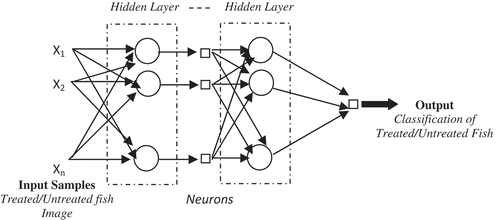
In random forest classifier, number of decision trees is the main control parameter. Training data are used to create multiple decision trees from generated random vector. The performance of classifier is checked for different number of decision trees and best parameter is finally selected for classification of test samples of heart sounds. shows the process of random forest classifier used for machine learning. On the basis of the experiments performed, it was analysed that Random forest classifier gives highest accuracy to classify this fish data set.
Results and discussion
The proposed work is tested on a database of eight fish samples with three repetitions. Sampling is done on six different days—6 days *8 fish *3 replication = 144 samples. The statistical features from the saturation channel are calculated and analysed for the fish samples which were sampled for consecutive six days. It was observed that statistical parameters of ROI in saturation channel showed discrimination between untreated and pesticide treated samples as shown in . and show the extracted first-order statistical features’ mean, standard deviation and second-order features like variance of an ROI (eye and pupil of the eye) in saturation channel for some fish samples and its variation.
Table 3. Statistical parameters of ROI (pupil of the eye) on basis of pixel intensity for untreated and treated fish.
Table 4. Statistical parameters of ROI (eye) on basis of pixel intensity for untreated and treated fish.
By using the results obtained, which shows discriminatory behaviour in the statistical features of the segmented region, different supervised classifiers are used for differentiation between untreated and pesticide treated fishes. In this proposed method, experiments are performed in a data set of 144 images of fish samples. In which 72 images are from untreated fish samples and remaining 72 images belong to pesticide treated fish samples. 80 images out of 144 are utilised as training set for classifier and 64 images are used as testing set to test the performance of different classifiers in terms of accuracy. Initially training images are divided into two groups as untreated samples and pesticide treated samples. shows the classifiers’ performance, number of samples that are used to train different classifiers and number of samples of fish used for testing. 40 samples belong to untreated fish group and 40 samples belong to pesticide treated fish class used for training of classifiers. To check the performance of different classifiers in terms of accuracy, 32 samples of untreated (fresh water) fish and 32 samples of pesticide (cypermethrin) treated are used. The samples that are used for testing were different from training samples. shows the accuracy of different classifiers. shows the confusion matrix for the best classifier result and shows the comparison of accuracy of classification between both ROI (eye and pupil of the eye). The results indicate that features from the pupil of the eye gives good classification results. As eye of any stored fish start shrinking gradually which may affect the result of classification, the pupil of the eye is a better choice as ROI for classification between pesticide (cypermethrin) treated and untreated fish (fresh water). The time complexity of the proposed method for fish classification is calculated in terms of time required for detection of the ROI segmentation and feature extraction using MATLAB programs on a laptop (2.30 GHz Intel Core i5 and 4 GB RAM). shows the computational time taken by proposed method for region segmentation and feature extraction.
Table 5. Accuracy of classification using different classifier for pupil of the eye as ROI.
Table 6. Computation time taken by proposed method for ROI segmentation andfeature extraction (for some samples).
Remarks and Discussion
Pesticide (cypermethrine) residue analysis in fish tissue depicts a ppb (ng/g) level accumulation whereas no accumulation is found in the untreated fish. Pesticide is responsible for the subtle colour change recorded in the image of eye tissue.
The statistical features of the segmented ROI gives discriminatory features for classification between fresh water fish and pesticide treated fish that makes it possible for identification of presence of pesticide in fish.
The experimental results indicate that the fish images under consideration are accurately classified as pesticide treated or fresh water fish with 90% to 97% accuracy.
Conclusion
The work proposes an image processing-based method for classification of pesticide exposed fish from fresh water fish. The method is non-destructive and a novel technique that can handle large number of samples in less time. The eye is considered as the focal tissue which has discriminatory image parameters for automatic classification. The segmentation of the fish eye and pupil of the eye from the image using the S-channel of HSV colour space is able to extract the most informative features used for automatic classifiers. The statistical features from the saturation channel have shown a clear variation which can be related to the variation in the pixel values between untreated (fresh water fish) and pesticide treated fish samples. An automated framework is designed which can perform automatic classification between pesticide treated and untreated fish. Classification is done by using different classifiers in which random forest gives best result of 96.87% accuracy and 100% sensitivity. Encouraging results have been obtained using the proposed framework and this can be considered as a significant contribution towards development of a non-destructive technology for fish quality assessment. The developed prototype can be used by fish industries and consumers as a method that suits real time applications.
References
- Baluyut, E. A. Aquaculture Systems and Practices: A Selected Review/FAO. Daya Publishing House. 1995. ISBN 10: 8170351499 / ISBN 13: 9788170351498
- Saeed, S. M.; Shaker, I. M. . Assessment of Heavy Metals Pollution in Water and Sediments and Their Effect on Oreochromis Niloticus in the Northern Delta Lakes, Egypt. Proceedings of the 8th International Symposium on Tilapia in Aquaculture, Cairo, Egypt. 2008. 475–490.
- Jan, M. R.; Shah, J.; Khawaja, M. A.; Gul, K. DDT Residue in Soil and Water in and around Abandoned DDT Manufacturing Factory. Environmental Monitoring and Assessment 2009, 155, 31–38.
- Sarkar, B.; Chatterjee, A.; Adhikari, S.; Ayyappan, S. Carbofuran and Cypermethrin Induced Histopathological Alterations in the Liver of Labeorohita (Hamilton) and Its Recovery. Journal of Applied Ichthyology. 2005, 21, 131–135.
- Adhikari, S.; Sarkar, B.; Chatterjee, A.; Mahapatra, C. T.; Ayyappan, S. Effects of Cypermethrin and Carbofuran on Certain Hematological Parameters and Prediction of Their Recovery in a Freshwater Teleost, Labeorohita (Hamilton). Ecotoxicology and Environmental Safety 2004, 58(2), 220–226.
- Olafsdottir, G.; Nesvadba, P.; Di., N. C.; Careche, M.; Oehlenschlager, J.; Tryggvadottir, R.; Schubring, R.; Kroeger, M.; Heia, K.; Esaiassen, M.; Macagnano, A.; Jorgensen, B. Multisensor for Fish Quality Determination. Trends in Food Science and Technology 2004, 15, 86–93.
- Nollet, L. M. L.; Toldra, F.; Editors. Seafood and Seafood Product Analysis; CRC Press: Boca Raton, FL, USA, 2010; pp. 169.
- Abbas, K. A.; Mohamed, A.; Jamilah, B.; Ebrahimian, M. A Review on Correlations between Fish Freshness and pH during Cold Storage. American Journal of Biochemistry and Biotechnology 2008, 4(4), 416–420.
- Sun, D. W.;; Editor. Computer Vision Technology for Food Quality Evaluation; Academic Press: Elsevier,Amsterdam, The Netherlands, 2008; pp. p. 188.
- Fırat, O. 1.; Cogun, H. Y.; Yüzereroğlu, T. A.; Gök, G.; Fırat, O.; Kargin, F.; Kötemen, Y. A Comparative Study on the Effects of A Pesticide (Cypermethrin) and Two Metals (Copper, Lead) to Serum Biochemistry of Nile Tilapia Oreochromisniloticus. Fish Physiology Biochemistry 2011 Sep, 37(3), 657–666.
- Escuder-Gilabert, L.; Peris, M. Review: Highlights in Recent Applications of Electronic Tongues in Food Analysis. Analytica Chimica Acta 2010, Volume 665(Issue 1, 14), Pages 15–25.
- Iqbal, A.; Valous, N. A.; Mendoza, F.; Sun, D.-W.; Allen, P. Classification of Pre-Sliced Pork and Turkey Ham Qualities Based on Image Colour and Textural Features and Their Relationships with Consumer Responses. Meat Science 2010, 84, 455–465.
- Melendez-Martinez, A. J.; Vicario, I. M.; Heredia, F. J. Instrumental Measurement of Orange Juice Colour: A Review. Journal of the Science of Food and Agriculture 2005, 85, 894–901.
- Pons-Sanchez-Cascado, S.; Vidal-Carou, M. C.; Nunes, M. L.; Veciana-Nogues, M. T. Sensory Analysis to Assess the Freshness of Mediterranean Anchovies (Engraulis Encrasicholus) Stored in Ice. Food Control 2006, 17(7), 564–569.
- Dutta, M. K.; Singh, A.; Ghosal, S. A Computer Vision Based Technique for Identification of Acrylamide in Potato Chips. Computers and Electronics in Agriculture 2015, 119, 40–50.
- Dutta, M. K.; Singh, A.; Ghosal, S. An Imaging Technique for Acrylamide Identification in Potato Chips in Wavelet Domain. LWT - Food Science and Technology 2016, 65, 987–998.
- Dutta, M. K.; Sengar, N.; Minhas, N.; Sarkar, B.; Goon, A.; Banerjee, K. Image Processing Based Classification of Grapes after Pesticide Exposure. LWT - Food Science and Technology 2016, 72, 368–376.
- Md, S.; Gopal, I. A.; Sankaranarayanan, P. E.; Nair, A. B. Classification of Selected Citrus Fruits Based on Color Using Machine Vision System. International Journal of Food Properties 2015, 19(2), 272–288.
- Ghasemi-Varnamkhasti, M.; Goli, R.; Forina, M.; Mohtasebi, S. S.; Shafiee, S.; Naderi-Boldaji, M. Application of Image Analysis Combined with Computational Expert Approaches for Shrimp Freshness Evaluation. International Journal of Food Properties 2015, 19(10), 2202–2222.
- Ziaratban, A.; Azadbakht, M.; Ghasemnezhad, A. Modeling of Volume and Surface Area of Apple from Their Geometric Characteristics and Artificial Neural Network. International Journal of Food Properties 2016, 20(4), 762–768.
- Lawless, H. T.; Heymann, H. Sensory Evaluation of Food: Principles and Practices; second. Springer: California, Davic, 2010.
- Brosnan, T.; Sun, D. Improving Quality Inspection of Food Products by Computer Vision – A Review. Journal of Food Engineering 2004, 61(1), 3–16.
- Majid, D.; Mohtasebi, S. S.; Omid, M.; Razavi, S. R.; Jamzad, M.; Guardia, M. D. L. Freshness Assessment of Gilthead Sea Bream (Sparus Aurata) by Machine Vision Based on Gill and Eye Colour Changes. Journal of Food Engineering 2013, 119, 277–287.
- Dutta, M. K.; Sengar, N.; Kamble, N.; Banerjee, K.; Minhas, N.; Sarkar, B. Image Processing Based Technique for Classification of Fish Quality after Cypermethrine Exposure. LWT – Food Science and Technology 2016, 68, 408–417.
- Dutta, M. K.; Issac, A.; Minhas, N.; Sarkar, B. Image Processing Based Method to Assess Fish Quality and Freshness. Journal of Food Engineering 2016, 177, 50–58.
- Freshness Ratings: Council Regulation (EEC) No. 103/76 OJ No. L20 (28 January 1976) (EEC, 1976)
- Tripathi, V. K.; Yadav, R. K. Effect of Pesticide (Organophosphorus) on Aquatic Fish Labeo Rohita. International Journal of Chemistry Science 2015, 13(2), 625–640.
- Dawar, F. U.; Zuberi, A.; Azizullah, A.; Khattak, M. N. K. Effects of Cypermethrin on Survival,Morphological and Biochemical Aspects of rohu(Labeorohita) during Early Development. Chemosphere 2016, 144, 697–705.
- Cristianini, N.; Shawe-Taylor, J. An Introduction to Support Vector Machines and Other Kernel-Based Learning Methods; Cambridge University Press: New York, NY, USA. 2000. ISBN 0-521-78019-5.
- Rosasco, L.; Vito, E.; Caponnetto, A.; Piana, M.; Verri, A. Are Loss Functions All the Same. Neural Computation 2004, 16(5), 1063–1076.
- Webb, G. I.; Boughton, J.; Wang, Z. Not So Naive Bayes: Aggregating One-Dependence Estimators. Machine Learning. Springer 2005, 58(1), 5–24.
- Graves, A.; Liwicki, M.; Fernandez, S.; Bertolami, R.; Bunke, H.; Schmidhuber, J. A Novel Connectionist System for Improved Unconstrained Handwriting Recognition. IEEE Transactions on Pattern Analysis and Machine Intelligence 2009, 31(5), 577–584.

